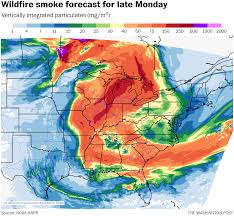
Understanding the Smoke Forecast
As wildfires continue to pose a significant threat to both nature and public health, the relevance of smoke forecasts cannot be overstated. The smoke produced by these fires carries harmful pollutants that can severely affect air quality across vast regions. This is particularly critical in Canada, where recent years have seen an uptick in wildfires due to rising temperatures and changing climate patterns.
Recent Developments in Wildfire Smoke Forecasting
As we move through the wildfire season, meteorological institutions and environmental agencies are ramping up efforts to provide real-time smoke forecasts. Environment and Climate Change Canada (ECCC) has been actively updating forecasts that track the movement of smoke plumes across provinces, allowing residents to take necessary precautions. For example, as of early September 2023, smoke from wildfires in British Columbia has affected air quality in Alberta and even as far east as Manitoba.
Recent data indicates that areas under smoke advisories experienced significant spikes in fine particulate matter (PM2.5)—a key indicator of air pollution that can penetrate lungs and enter the bloodstream. According to the Canadian Air Quality Health Index, levels of PM2.5 in some regions have risen above safe thresholds, prompting health alerts.
The Impacts of Smoke on Health and Environment
The implications of poor air quality caused by wildfire smoke extend beyond immediate health concerns; it can lead to long-term respiratory issues, aggravate pre-existing medical conditions, and undermine overall public health efforts. Vulnerable groups, including children and those with respiratory conditions, are at a heightened risk. Furthermore, the environmental impact includes the deposition of ash and harmful particulates affecting soil and water quality, contributing to a cycle of ecological degradation.
Preparing for High Smoke Forecasts
In light of the ongoing wildfire situation, Canadians are urged to stay informed about smoke forecasts. Public health officials recommend that individuals limit outdoor activities during high smoke days, use air purifiers, and, if necessary, wear masks designed for smoke protection.
Furthermore, individuals should monitor updates from national weather services and local authorities regarding smoke forecasts to understand when their area is at risk. These measures can go a long way in safeguarding health and well-being during wildfire seasons.
Conclusion
In summary, effective smoke forecasting is essential for mitigating the risks associated with wildfires. With the increase in frequency and intensity of wildfires attributed to climate change, staying informed and prepared is more important than ever. As Canada approaches the peak months of wildfire season, understanding the smoke forecast will be crucial for protecting public health and the environment.



